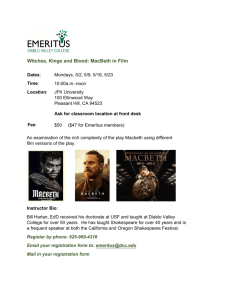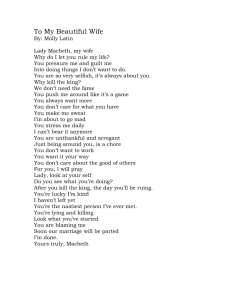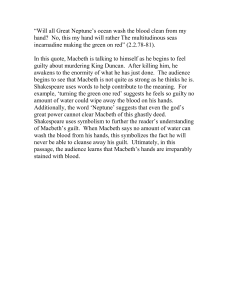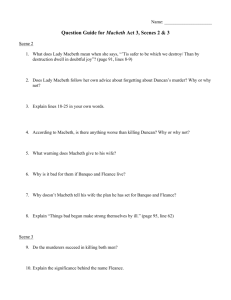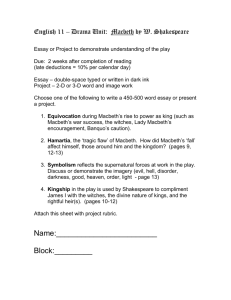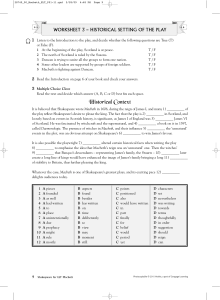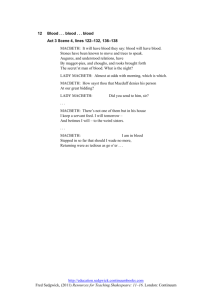Elizabethan Theatre Form Study Notes
advertisement
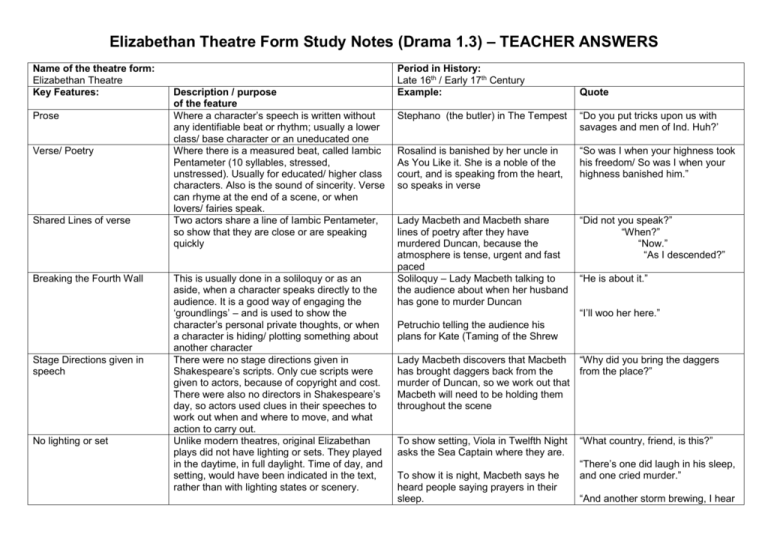
Elizabethan Theatre Form Study Notes (Drama 1.3) – TEACHER ANSWERS Name of the theatre form: Elizabethan Theatre Key Features: Prose Verse/ Poetry Shared Lines of verse Breaking the Fourth Wall Stage Directions given in speech No lighting or set Description / purpose of the feature Where a character’s speech is written without any identifiable beat or rhythm; usually a lower class/ base character or an uneducated one Where there is a measured beat, called Iambic Pentameter (10 syllables, stressed, unstressed). Usually for educated/ higher class characters. Also is the sound of sincerity. Verse can rhyme at the end of a scene, or when lovers/ fairies speak. Two actors share a line of Iambic Pentameter, so show that they are close or are speaking quickly This is usually done in a soliloquy or as an aside, when a character speaks directly to the audience. It is a good way of engaging the ‘groundlings’ – and is used to show the character’s personal private thoughts, or when a character is hiding/ plotting something about another character There were no stage directions given in Shakespeare’s scripts. Only cue scripts were given to actors, because of copyright and cost. There were also no directors in Shakespeare’s day, so actors used clues in their speeches to work out when and where to move, and what action to carry out. Unlike modern theatres, original Elizabethan plays did not have lighting or sets. They played in the daytime, in full daylight. Time of day, and setting, would have been indicated in the text, rather than with lighting states or scenery. Period in History: Late 16th / Early 17th Century Example: Quote Stephano (the butler) in The Tempest “Do you put tricks upon us with savages and men of Ind. Huh?’ Rosalind is banished by her uncle in As You Like it. She is a noble of the court, and is speaking from the heart, so speaks in verse “So was I when your highness took his freedom/ So was I when your highness banished him.” Lady Macbeth and Macbeth share lines of poetry after they have murdered Duncan, because the atmosphere is tense, urgent and fast paced Soliloquy – Lady Macbeth talking to the audience about when her husband has gone to murder Duncan “Did not you speak?” “When?” “Now.” “As I descended?” “He is about it.” “I’ll woo her here.” Petruchio telling the audience his plans for Kate (Taming of the Shrew Lady Macbeth discovers that Macbeth “Why did you bring the daggers has brought daggers back from the from the place?” murder of Duncan, so we work out that Macbeth will need to be holding them throughout the scene To show setting, Viola in Twelfth Night asks the Sea Captain where they are. To show it is night, Macbeth says he heard people saying prayers in their sleep. “What country, friend, is this?” “There’s one did laugh in his sleep, and one cried murder.” “And another storm brewing, I hear it sing in the wind.” Men played women parts Women were not allowed on the stage as it was not seen as an appropriate profession for women. Shakespeare used this to create humour at times, and has many examples of women dressing up as men in his plays Amplified vocal/ physical performances Actors in Shakespeare’s day had to amplify their voices and move in big, bold ways because they were playing to about 3000 people in an outdoor theatre, from different classes in society. Shakespeare used imagery in his work, such as metaphors, similes, personification, in order to create images in the audiences’ mind. Because there was no lighting or set, the words helped to create the scene. Elizabethans often talked of going to ‘hear’ a play – not ‘see’ one (audience comes from audio) so the way words were used were creative and imaginative to keep the audience interested and engaged with characters and plot Use of imagery Prologues This is the introduction to the play, and often involves an actor playing the ‘prologue’ character, and addressing the audience directly. It was common to outline the entire plot to follow in the prologue, or to beg the audience to use their imaginations for the next two hours To show weather, Trinculo (The Tempest) tells us a storm is coming The character of Viola in Twelfth Night would have been played by a man, and she then dresses up as a man, Cesario. “I am not what I am.” No example No example Macbeth uses personification for sleep, because he thinks he has heard someone cry out that Macbeth has ‘murdered sleep’ and you can’t kill sleep; but he does feel guilty about murdering Duncan. “The innocent sleep – sleep that knits up the ravelled sleeve of care.” The Sea Captain compares Sebastian to a legendary Greek musician who saved himself by jumping overboard and riding a dolphin to safety, by using a simile(Twelfth Night) Olivia uses a metaphor to compare love with a sickness – the plague Prologue in Romeo and Juliet explains the death of both main characters Prologue in Henry V asks the audience to use their imagination Prologue in the play within the play in A Midsummer Night’s Dream explains who is playing what and the entire plot. “Where, like Arion on the dolphin’s back, I saw him hold acquaintance with the waves.” “Even so quickly can one catch the plague?” “A pair of star crossed lovers take their life.” “Think, when we talk of horses, that you see them.” “This beauteous lady is Thisbe, certain.”

